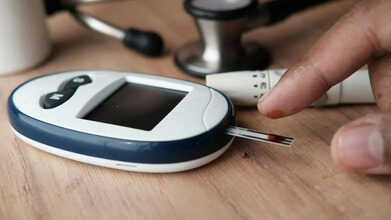- Health Conditions A-Z
- Health & Wellness
- Nutrition
- Fitness
- Health News
- Ayurveda
- Videos
- Medicine A-Z
- Parenting
- Web Stories
Strengthen Your Hair, Skin And Nail Health With These 8 Nutrient-Packed Foods

Image Credit: Canva
Glossy hair, radiant skin, and strong nails are more than aesthetic markers-they are reflections of your overall health. While drugstore shelves are lined with products promising miraculous results, the real game-changer lies not on your vanity but in your kitchen. Your diet plays an essential role in nurturing these three areas, offering long-term benefits that no topical product can rival.
You are what you eat" isn't just a funny phrase; it's scientific fact-when it comes to hair, skin, and nails, anyway. A 2019 research review said there are correlations between low levels of micronutrients and ailments like acne, eczema, hair loss, and brittle nails. Among the nutrients deficient in cases of fragile nails, pale skin, and thinning hair are vitamins A, B, C, and E, as well as zinc, iron, and omega-3 fatty acids.
The good news? There are ways to revive those areas naturally by incorporating some specific nutrient-rich foods into your diet.
Hair Health
Hair is made of keratin, a type of protein. Protein intake is crucial to its growth and strength. A deficiency in iron, omega-3s, and biotin will result in dry, brittle strands, even hair loss.
Skin Health
Your skin is your largest organ, and its health is determined by hydration, collagen production, and antioxidant defenses. Nutrients such as vitamin C, omega-3s, and beta-carotene support elasticity, reduce inflammation, and protect against premature aging.
Nail Health
Nails show mineral and vitamin levels in the body. Brittle nails or ridges could be a sign of low levels of iron, zinc, or B vitamins, and a lack of omega-3s can weaken nails and make them more susceptible to breaking.
Foods that can Help Strengthen your Hair, Nail and Skin
1. Seafood
Rich in omega-3 fatty acids, seafood—especially salmon, sardines, and mackerel—help nourish the scalp and diminish inflammation in the skin. Omega-3s play a vital role in supporting the barrier function of the skin and maintaining a glowing, well-hydrated complexion.
Why It Works:
- Reduces redness and irritation
- Supports shiny, strong hair
- Balances omega-6 levels for healthier skin
Alternative: Flaxseed oil is a plant-based, rich source of omega-3s.
2. Sweet Potatoes
Rich in beta-carotene, sweet potatoes are a precursor to vitamin A, which helps the regeneration of cells in the skin and nails. It also prevents dryness and flakiness.
How It Works:
- Boosts collagen production
- Protects against free radicals that lead to aging
- Helps in increasing nail thickness and strength
3. Dark Leafy Greens
Spinach, kale, and Swiss chard are iron powerhouses, vitamin C powerhouses, and antioxidant powerhouses. These greens fight dull skin, brittle nails, and hair loss resulting from iron deficiency.
Why It Works:
- Increases oxygen flow to hair follicles
- Provides necessary hydration for skin
- Strengthens nails with key minerals
4. Nuts
Almonds, walnuts, and Brazil nuts are loaded with vitamin E, biotin, and zinc, which repair cells and hydrate them. A small handful daily can dramatically improve hair and nail strength.
Why It Works:
- Protects against UV damage
- Prevents hair breakage
- Nourishes dry, brittle nails
5. Kiwi and Citrus fruits
Vitamins C found in kiwis, oranges, and grapefruits enhance the formation of collagen that is the skin structural protein responsible for giving skin firmness and toughness.
Why It Works:
- Smoothens and tightens up the skin
- Wrinkles and drooping decrease
- Splits and breaking off of nails decrease
6. Eggs
Egg is one protein source that offers the production amino acids of keratin and in addition contains biotin that strengthens hair and nails.
Why It Works:
- Prevents brittle, thinning hair
- Thickens nails
- Promotes healthy scalp
7. Muesli and Whole Grains
Whole grains such as oats are a good source of B vitamins and antioxidants that help promote healthy skin and prevent the ridges caused by a deficiency in nutrients.
Why It Works:
- Reduces dry, flaky skin
- Boosts nail growth
- Provides long-lasting energy for cell repair
8. Dark Chocolate (70% or More)
Dark chocolate is full of flavonoids, antioxidants that enhance blood flow and hydration to the skin. Moderation is a must, but adding a square or two daily can work wonders.
Why It Works:
- Protects against sun damage
- Increases elasticity
- Enhances hair shine
Foods to Avoid
Certain foods can derail your progress:
- Alcohol, which dehydrates the skin
- Processed foods, which causes inflammation
- Dietary beverages, which age quickly
No topical product can outshine the benefits of a balanced, nutrient-rich diet. These eight foods added to your meals will enhance your hair, skin, and nails and improve your health as a whole. Beauty is not just about looks; it's feeling good from the inside out.
Ready to make the switch? Head to your local farmer's market and stock up on these natural beauty boosters today.
Hair, Nails, and Skin: Differentiating Cutaneous Manifestations of Micronutrient Deficiency. Nutr Clin Pract. 2019.
Acne Severity and Sleep Quality in Adults. Clocks Sleep. 2019
Diet and hair loss: effects of nutrient deficiency and supplement use. Dermatol Pract Concept. 2017
Severe Headaches Around Periods Are Not Normal: Neurologist Reveals Real Reason Behind A 35 Y/O Woman's Pain

Periods are different for all women. While some may experience mild pain and discomfort during their periods, others experience extreme pain and a myriad of symptoms. Sharing an instance of the same, in a recent post, Dr Sudhir Kumar, a Hyderabad-based Neurologist shared the story of a young woman struggling with debilitating pain, with real answer for it.
Anita, a 35-year-old school principal from Hyderabad, was full of energy and passion for her work. But for several months, two days a month became a nightmare. Like clockwork, right around her period, she would get terrible, throbbing headaches. These headaches were so bad they would often come with nausea and a strong dislike for light. On these days, it was hard for her to do anything, but she would still force herself to go to work with a fake smile.
At home, her family saw her pain. At school, her staff noticed she was pulling away. The headaches were slowly stealing her confidence at work and her happiness at home.
What Causes Headaches During Periods?
Anita first went to her family doctor and then to a women's health specialist. Some medicines helped for a short time, but they didn't stop the headaches from coming back every month. She was frustrated that no one seemed to understand what she was going through.
Finally, she came to see Dr Sudhir Kumar, a Hyderabad-based neurologist. In the post he explained that after listening carefully to her story the diagnosis was clear: Anita had menstrual migraines. These are headaches that are directly connected to the hormone changes that happen during a woman's menstrual cycle.
With the right treatment, Anita's migraines became less frequent and easier to manage. Her energy and vibrant personality returned. The school principal who once dreaded those two days of the month was now back to her confident self. When she last visited the clinic, she told her doctor, "You gave me my life back," expressing her relief and gratitude for finally being understood and effectively treated.
Why Do I Get Headaches Before Periods?
According to the Migraine Trust, a menstrual migraine is a type of migraine that's specifically linked to a woman's menstrual cycle. These migraines typically occur from about two days before a period begins to the third day of the period, but the timing can vary from person to person.
Menstrual migraines are very common. It's estimated that as many as two-thirds of women who experience migraines have attacks that are related to their periods. This condition can start when a woman first gets her period and can continue until menopause.
How Are Menstrual Migraine Different Than Regular Migraines?
Menstrual migraines often stand out from other types of migraines. They tend to be longer and more severe. Besides head pain, they're more likely to cause nausea, vomiting, and sensitivity to light or sound.
Also, these migraines usually happen without an aura, which is a visual disturbance or other symptom that can come before a migraine. They can also be harder to treat than migraines that occur at other times of the month.
Why Do Menstrual Migraines Happen?
The main reason for menstrual migraines is the link between migraines and hormones. A drop in the hormone estrogen is a well-known migraine trigger. As a woman's period approaches, her estrogen levels naturally fall, which increases the likelihood of a migraine attack.
Hormone-like substances called prostaglandins also play a role. The body releases more prostaglandins during a period, which can cause period cramps and also increase the risk of a migraine.
How To Recognize Menstrual Migraines?
A key factor in this condition is that to identify it no specific test exists. Doctors can't run a lab test to diagnose a menstrual migraine. The Migraine Trust reveals a few key points that can help you identify whether you have menstrual migraines.
Keep a diary to track symptoms
The most accurate way to check for a link is to keep a detailed diary for at least three months. In it, you should record both your migraine attacks and the dates of your menstrual period.
Look for a pattern
Menstrual migraines are defined as attacks that happen between two days before your period and the third day of your period. This pattern must occur during at least two out of three menstrual cycles.
Consult a doctor
Your doctor can review your diary and confirm if you have a menstrual migraine based on the timing and your symptoms.
Ozempic May Not Be Helpful If You Continue Emotional Eating: Study

(Credit-Canva)
Weight loss dependent on Ozempic has increased immensely, however, does Ozempic work for everyone? A new study showed that people who eat due to extreme emotions actually may not lose weight.
Ozempic and Wegovy are powerful drugs that can help people with diabetes manage their blood sugar and lose weight. But they don't work the same for everyone. A recent study from Japan sheds light on why, suggesting that how you eat, whether it's due to external triggers or emotional feelings, can affect how well these drugs work for you.
How Your Eating Habits Affect Weight Loss On Ozempic
Scientists in Japan followed 92 people with type 2 diabetes for a year after they started taking GLP-1 receptor agonists (like Ozempic). They wanted to see if a person's eating habits had any connection to the success of the treatment. They focused on three eating behaviors:
Emotional eating: Eating in response to feelings like sadness or stress, not because you're hungry.
External eating: Eating because of outside cues, like the sight or smell of delicious food, even if you're not hungry.
Restrained eating: Actively trying to control your diet to lose weight.
After a year, the study found that most people on the drugs lost weight and saw improvements in their body fat and cholesterol. However, when they looked at the different eating behaviors, they found some key differences.
How Do You Lose The Most Weight On Ozempic?
The study found that people who were prone to external eating at the start of the study had the best results in terms of weight loss and blood sugar control. The drugs seemed to be most effective for them over the long term.
On the other hand, the drugs were less effective for people who were prone to emotional eating. The researchers believe this is because emotional eating is tied to psychological factors that the medication doesn't directly address. This suggests that people who eat for emotional reasons might need extra support, like counseling, to see the best results from these drugs.
Dr. Daisuke Yabe, the study's senior author, noted that assessing a patient's eating behaviors before treatment could help doctors predict who will benefit most from these medications.
This was an observational study, which means it can't prove that eating habits directly cause the different outcomes. But the findings are promising and suggest a potential link. More research is needed, but if these results are confirmed in larger studies, doctors might one day use simple questions about eating habits to help personalize treatment plans for people taking drugs like Ozempic and Wegovy.
Which Diet Works Best For Ozempic
Your Diet plays a very important role in ensuring how much weight you will lose, even while taking medication like Ozempic. Here is how you maximize the benefits of the same according to American Association of Retired Persons (AARP,
Focus on Nutrient-Rich Foods
Because your appetite will be smaller, every bite counts. Choose whole, unprocessed foods like vegetables, fruits, and lean proteins. This is especially important for older adults who are more prone to vitamin deficiencies.
Don't Skip Meals
The medication can make it easy to forget to eat. To avoid feeling weak or losing muscle, try to schedule your meals or even set an alarm to remind yourself.
Make Protein a Priority
Protein is essential for keeping your muscles strong. Aim for at least 60 grams of protein a day, focusing on sources like chicken, fish, eggs, yogurt, and beans. A good tip is to eat your protein first at every meal.
Stay Hydrated
Drink at least 64 ounces of water or other fluids each day. This helps prevent dehydration and a common side effect: constipation. If you feel tired or get muscle cramps, you might need to add electrolytes to your water.
Avoid Fatty and Sugary Foods
Since the drugs slow down digestion, heavy, greasy foods like French fries and pizza can cause bloating, gas, and an upset stomach. It's also best to limit sugary foods and refined carbs (like white bread) as they can cause blood sugar spikes that make you feel tired and nauseous.
Eat Smaller, More Frequent Meals
Instead of three big meals, try eating smaller portions more often. This gives your body time to properly digest food and can help with nausea and heartburn.
Increase Your Fiber Intake
Constipation affects up to a third of users. To keep things regular, eat plenty of fiber-rich foods like fruits, vegetables, and beans. A fiber supplement can also help, especially in the beginning.
Prediabetes: How To Spot the Silent Warning Signs Before It Turns Into Type-2 Diabetes

Credits: Canva
Prediabetes occurs when blood sugar levels rise but do not reach the threshold for Type 2 diabetes. For those unversed, healthy blood sugar (glucose) levels range from 70 to 99 milligrammes per decilitre (mg/dL). If you have undetected prediabetes, your levels are normally between 100 and 125 mg/dL. According to the American Diabetes Association, people who are 45 years old with prediabetes have a 9% to 14% chance of getting Type 2 diabetes within 10 years.
The good news is that prediabetes can be reversed via healthy lifestyle modifications. As people become more prone to prediabetes, let's look at what it is and how to recognise the early warning symptoms before they progress to something more dangerous, such as type 2 diabetes. We contacted Dr Rakesh Pandit, Senior Consultant and Head of Internal Medicine at Aakash Healthcare, who informed us about the situation.
What is Prediabetes?
According to Dr Rakesh Pandit, prediabetes is a condition in which your blood sugar levels are higher than normal but have not yet reached the threshold for type 2 diabetes. This is usually reflected in fasting blood glucose readings above the normal range and an HbA1c between 5.7% and 6.5%. Without changes to lifestyle, both adults and children with prediabetes are at significant risk of progressing to type 2 diabetes.Dr Pandit adds that even in this early stage, the long-term effects of elevated blood sugar on the heart, blood vessels, and kidneys may already begin. The good news is that developing full-blown type 2 diabetes is not inevitable. Simple measures such as eating a balanced diet, staying physically active, and maintaining a healthy weight can often bring blood sugar back to normal. These same strategies are effective for children as well, helping to restore healthy glucose levels.
How is Prediabetes Different from Type-2 Diabetes?Prediabetes occurs before a diagnosis of diabetes is made. People with prediabetes have blood sugar levels higher than normal but usually do not experience symptoms of diabetes. Normal fasting blood glucose ranges from 70–99 mg/dL, while prediabetes typically shows levels between 110–125 mg/dL or an HbA1c of 5.7%–6.5%. These numbers are not high enough for a diabetes diagnosis, which is why many remain unaware of their prediabetes status.
Dr Pandit told us, “Prediabetes not only increases the risk of developing type 2 diabetes but also raises the likelihood of cardiovascular disease and stroke. People diagnosed with prediabetes should have their blood sugar monitored every 1–2 years. If results are normal, testing can be repeated every three years”. Lifestyle interventions, such as improved nutrition and regular exercise are the first step in preventing the roughly 70% chance of progressing to diabetes.
Symptoms Of Prediabetes In Females
While prediabetes often shows no clear symptoms, if present, they can include increased thirst, frequent urination, fatigue, blurred vision, and darkened skin patches in areas like the neck and armpits. In women specifically, Dr Pandit notes it may also cause vaginal dryness, menstrual irregularities, decreased fertility, and a higher risk of yeast infections.ALSO READ: What Is Tylenol? Can It Really Be Linked to Autism? Doctors Explain
Symptoms and Risks of PrediabetesYou can have prediabetes for several years without noticing any signs. It often goes undetected until more serious complications, like type 2 diabetes, develop.
Dr Rakesh Pandit advises consulting your doctor for blood sugar testing if you have any risk factors, such as:
- Being overweight
- Age 45 or older
- Having a parent or sibling with type 2 diabetes
- Exercising less than three times a week
- History of gestational diabetes
- Having given birth to a baby weighing over 9 pounds
Race and ethnicity can also influence risk. African Americans, Hispanic/Latino Americans, American Indians, Alaska Natives, Pacific Islanders, and certain Asian American groups are more susceptible to developing prediabetes.
Can Prediabetes Be Reversed?Yes, lifestyle modifications like eating a balanced diet, exercising frequently, decreasing weight, and getting better sleep can reverse or postpone prediabetes. By bringing blood sugar levels back into a healthy range, these adjustments can stop or slow the onset of Type 2 diabetes. Support and direction are also provided by initiatives such as the National Diabetes Prevention Program to help people make these important lifestyle changes.
© 2024 Bennett, Coleman & Company Limited

